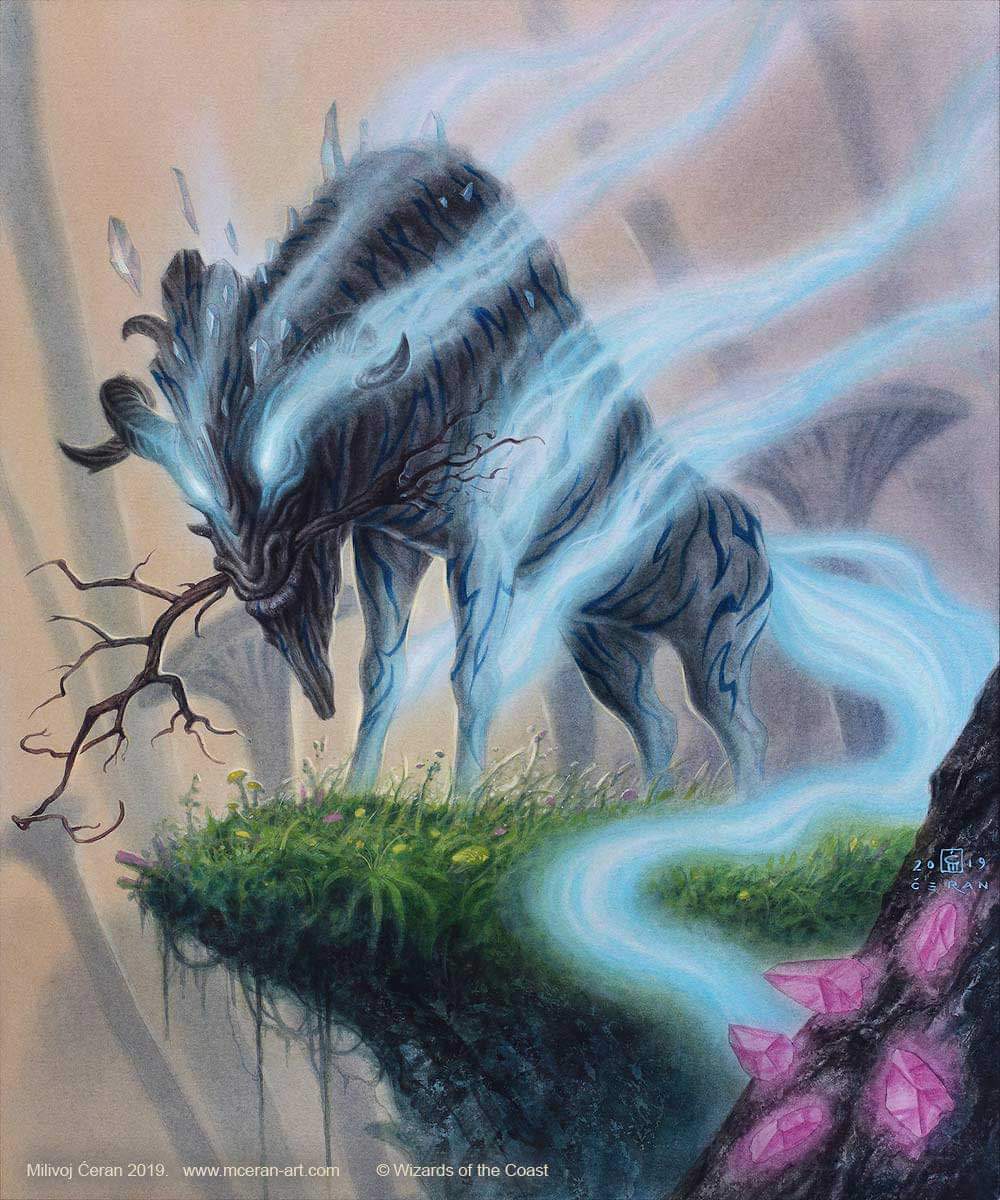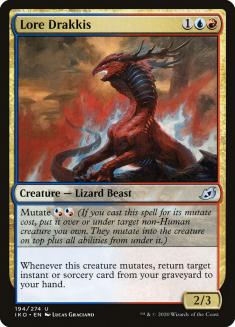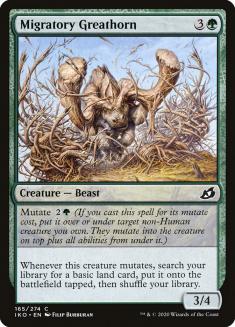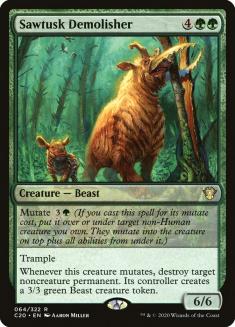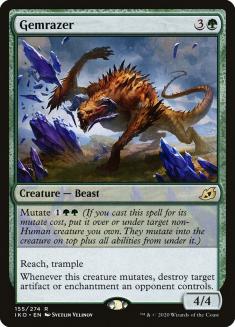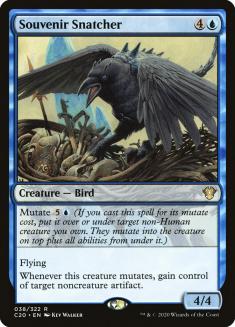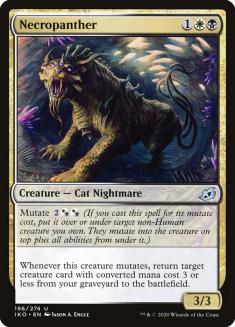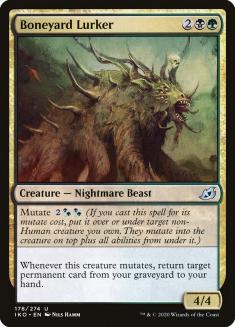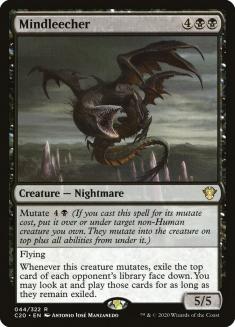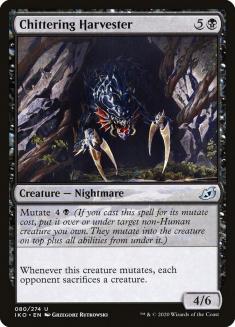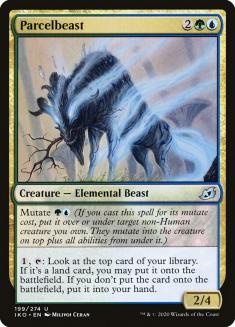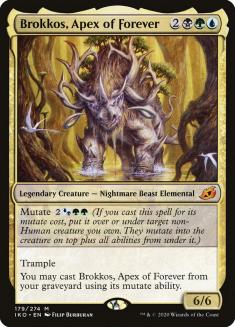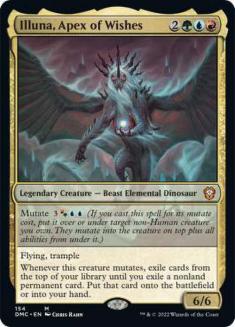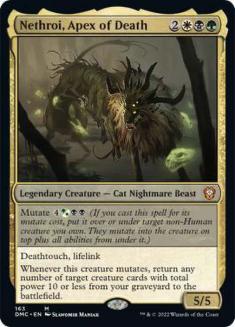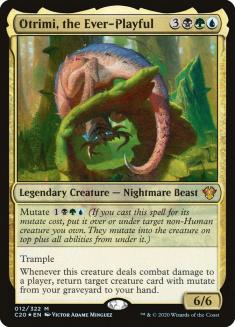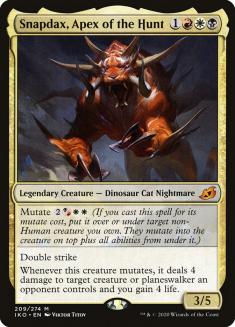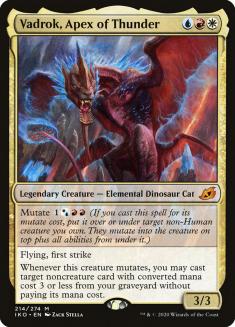Ikoria’s new mechanic mutate is full of promise for building compelling Commander decks. I’ll examine some of the cards that have mutate, consider how they’ll work in the format and pick the ten best of the nonlegendary ones. Then I’ll break down some ideas on decks for each of the potential commanders.
The upside of the mechanic is that you have the ability to build a creature stack to your liking, whether that’s making a small one with a cool ability larger or giving a larger one neat abilities. The downside is that you’re committing resources to a single pile, so you open yourself to getting two-for-one’d or worse with targeted removal. In my environment, sweepers are more prevalent than targeted removal. Wrath of God kills two individual creatures or one stack just the same.
Although it can at times be confusing, mutate isn’t a broken mechanic. In fact, it’s one that you have to do a little bit of work to take advantage of. That makes it just the kind of thing that’s perfect for Commander—the path to something thought-provoking which isn’t immediately obvious.
Remember that you can only mutate non-Humans. There were a few times when I was putting together this list that I had to go back and make sure about creature types.
I’m not a fan of the “for each time this creature has mutated” clause. I don’t mind doing a little work, but that seems like jumping through too many hoops. The one that got the biggest consideration from me was Auspicious Starrix, because getting it once was enough. You’ll see that it’s made it into the deck I built, but it’s still a highly situational role-player that needs a particular slot to fit into. To make it into the Top 10, a card had to be broadly useful.
Honorable Mentions: Cloudpiercer, Dreamtail Heron, Pouncing Shoreshark, Sea-Dasher Octopus
10. Lore Drakkis
I went back and forth on whether or not I really like Lore Drakkis. In the end, the very low mutate cost appealed to me. It might be the weakest of the cards on the list because its power and toughness aren’t compelling enough to make it the top creature, but it also doesn’t have any evasion abilities. Still, getting that spell back for just two mana is good stuff.
9. Migratory Greathorn
This is an excellent one to curve onto a mana or ramp creature, offering up double benefits in your creature-heavy builds. It’s also a Beast, so it’ll slot right into your tribal decks. I’m considering returning Cloudstone Curio to my Animar deck, and if I do, Migratory Greathorn could make an appearance. It’s pretty saucy for a common.
8. Sawtusk Demolisher
You’re certainly putting Sawtusk Demolisher on top of a smaller creature, lending its large, tramply body to a small flyer or mana creature, likely one that helped you get to it in the first place. It’s a small thing, but I like playing cards that give creatures to other players alongside Suture Priest.
7. Gemrazer
I like the idea of a little curve here, mutating the 4/4 body onto a mana creature, like Birds of Paradise, in order to blow up the inevitable mana rock someone has dropped. Later in the game, of course, you’re wandering into a target-rich environment. Adding reach and trample to an even larger creature provides you with some serious beatstick capability.
6. Souvenir Snatcher
It will be good enough if you gain control of one artifact with Souvenir Snatcher, but why stop there? Play it in a Ninja deck, putting it and whatever you mutated it with back into your hand for runbacks. Although it’s not on this list, Pouncing Shoreshark also fits into this line, and putting both of them back is full of value.
5. Necropanther
Maybe my favorite new Cat Nightmare (Nightmare Cat has better rhythm to me, but I understand there’s some sort of pecking order to be maintained). Its not-quite-Sun Titan ability is in the colors of reanimation, so the thing you’re going to bring back to the battlefield—like maybe Saffi Eriksdotter in those Abzan decks—is itself likely to be a reanimation piece.
4. Boneyard Lurker
For just one more mana than Eternal Witness, you also get a body that’s battle-ready. Sure, you’re only getting back a permanent, but it’s in colors that really like permanents. One of those colors also likes putting stuff into the graveyard. There are certainly any number of loops that would have you casting Boneyard Lurker again and again, like in a Karador, Ghost Chieftain deck. As if I need a reason to build another one.
3. Mindleecher
What got me about Mindleecher is the fact that you can look at and play those cards even after Mindleecher has left the battlefield. If the card is something you just don’t want around, you can leave it exiled. If it’s a big, splashy card, like Decree of Pain or some such, then it’s well worth casting. Note that Mindleecher doesn’t have the additional ability that lets you use any color of mana to pay for the cost. I suspect that that text simply didn’t fit in the box. As a 5/5, Mindleecher is likely the body you want since the mutated creature will have flying in either case.
2. Chittering Harvester
Significant value for the five mana, most of the time getting a three-for-nothing. You can up the value by putting it into a deck that likes sacrifice, such as Thraximundar. If your commander has a smaller body, like Karlov of the Ghost Council or Elenda, the Dusk Rose, you can make them quite beefier. In fact, Chittering Harvester combos quite nicely with Elenda, since you’ll get her trigger as well.
1. Parcelbeast
The dream here is to turn Coiling Oracle into a creature that can “coil” every turn. Mutating with a creature that has inspired would be cool. Arbiter of the Ideal would be a great combo. When you untap it, if the card from the activated ability wasn’t a land, there’s a good chance that you can put it onto the battlefield. If you’re playing a Sultai deck, King Macar, the Gold-Cursed is the one you’ll want. It’s #1 on my list because it’s the one I’m most excited about brewing with.
Mutate Commanders
The cards on this list and some of the others with mutate will truly shine when brought together with the potential commanders that also have mutate. There are two advantages to mutate commanders. One is that you’ll get to use them multiple times (even if you have to still pay the commander tax on subsequent uses). Second is that the whole stack will be your commander, meaning regardless of which is on top, it will deal commander damage. The downside is that if you get hit with Leadership Vacuum, you’ll end up with non-commander cards stranded in your command zone. Between Ikoria and Commander 2020, there are six of them. Let’s break down each.
While it would seem that you want this is as one of the 99 (putting it into a Muldrotha, the Gravetide deck, for example) so that you can take advantage of it as a graveyard piece, you can still do that if it’s your commander. Mutate it from the command zone onto something cool—a creature with double strike seems pretty saucy—and then if it gets killed, simply let it go to the graveyard instead of the command zone—and no tax.
The first card you’ll want to put into your Brokkos deck is River Kelpie. The build I’d run with it would be Elemental tribal cards like Risen Reef (and old favorite Coiling Oracle). Utility creatures like Fertilid and Mulldrifter are Elementals, as well as big beaters like Lord of Extinction; Multani, Maro-Sorcerer; and everyone’s favorite, Avenger of Zendikar. What also might be compelling is a build with morph creatures. You can mutate onto them while they’re face down, then still be able to turn them face up for even more value.
Repeated instances of paying the mutate cost will get expensive (especially with the double blue requirement), but fortunately you’re in a color that has some bounce capability. Remember that the whole stack will bounce, so the best use case here is having creatures with good enters-the-battlefield triggers.
What’s compelling about Illuna is that while you’re likely to want to put the permanent you reveal onto the battlefield, you’re not required to. If the game state dictates that you’re better off casting it (like Kozilek, Butcher of Truth) or keeping it in your hand (if the environment is currently hostile to the permanent type), then you have the option.
Two cards which immediately came to mind with our bouncing were Nevermaker and Slithermuse. We get the chain started with cards like Roaring Primadox and Stampeding Wildebeests, and then get repeated value out of the first two, who trigger when they leave the battlefield. Cloudstone Curio also fits into this cycle. To this whole load of nonsense, I’d add The Ozolith and creatures with +1/+1 counters. Toothy, Imaginary Friend and Pir, Imaginative Rascal fit right into the theme as well (although Pir is a Human and can’t be mutated).
The first thing I’m going to try is just running Nethroi at the helm of my Karador deck. But we’re here to talk about other things to do with it. Still, many of the cards that Karador runs would be quite valuable. Saffi Eriksdotter and Karmic Guide can start your list, but low-power, high-value cards like Blood Artist, Suture Priest, and Duplicant make the cut.
The real value will be with creatures that have zero power and enter the battlefield with counters on them. Spike Feeder; Spike Weaver; Ghave, Guru of Spores; and one of my old favorites, Phantom Nishoba, all apply. You’re in the colors for Juniper Order Ranger to give the extra buffs. I might add Luminous Broodmoth to this mix to really get some spice. As I suggested with Illuna, The Ozolith might have some game here as well.
If you’re inclined toward infinite combos, you could Entomb for Mikaeus, the Unhallowed and Triskelion. Woodfall Primus; Melira, Sylvok Outcast; and a sacrifice outlet would work as well. There are actually quite a few infinites available to you. It’s certainly not a play pattern that interests me, but there are a fair number of folks who enjoy it, so I figured it’s worth mentioning.
I think maybe the flavorful build with Nethroi is Cat or Beast tribal, with Kaheera, the Orphanguard as companion. We could sprinkle in Elementals, Nightmares, and maybe even Dinosaurs. I’d primarily run Beasts with Ravenous Baloth in order to get the lifegain plus putting the creatures into the graveyard for later Nethroi use. There are 71 options for creatures in those types that also have a power of zero. That includes a few of the Arcbound creatures, to include Arcbound Ravager. Hidden Gem here: Riptide Mangler. This is the deck that I’m most likely to build out of the mutate commanders.
Certainly the narrowest of them all, Otrimi still has some intriguing possibilities. You’ll have to play most of the 24 mutate cards available in the Sultai wedge to do it, but there are a few stars, many of them on the above list. You can also play Brokkos as one of the 99. It’s also the one with the best possibility of getting mileage from the “X is the number of times this creature has mutated” mechanic. You’re really putting all your eggs in one basket here, so you’ll want to think of an Otrimi deck in the same way you think about a Voltron deck—protect the important creature.
The main way to go is likely the same path as a Voltron deck, namely getting those commander damage kills. The mutate cost is low, so you can find something with a large and variable-sized body like Lord of Extinction, get some trample with Sawtusk Demolisher, and then go to town.
I’m pretty happy that Mardu is becoming playable outside of Kaalia of the Vast. I’m quite fond of both of my Queen Marchesa decks. The one I’d build with Snapdax would follow similar lines as Queen Marchesa, Long May She Reign. While it might not seek to become the monarch (although it’s not outside the realm of reasonable possibilities), Snapdax wants to be dealing combat damage in an environment where not too many opposing creatures are around to do so.
The first card I jam is Basilisk Collar, so that Snapdax’s mutate trigger can kill anything, no matter how large. It also gets some of the other mutate cards, like Chittering Harvester, Dirge Bat, and Mindleecher. From there, some buffs on Snapdax can make it lethal pretty quickly with double striking commander damage. What you might use to get there is up to your personal tastes, whether you want Empyrial Armor, Sword of Feast and Famine, or Eldrazi Conscription.
The immediate path I see here is Lore Drakkis to help with multiple castings of Sevinne’s Reclamation and Frantic Search. The leads us down a whole flashback line, which probably includes Snapcaster Mage. I’d want to do something with Increasing Vengeance copying a big X-spell, which we’ve cast off the top of the library with help from Melek, Izzet Paragon. We certainly play Sun Titan so that we can get back permanents with CMC three or less as well, rounding out the package.
There are a few Sagas that have CMC three or less, making them recastable. History of Benalia will generate some Knight tokens, Medomai’s Prophecy sets up some cool card draw, and The Birth of Meletis is the kind of ramp the Jeskai wedge needs. The Saga angle suggests a whole enchantment line, from Banishing Light to getting back your Ghostly Prison if someone blows it up. There are more than 1,000 enchantments which cost three or less in Vadrok’s colors. There’s room for brewing something extraordinarily different.
Mutate is never going to be a dominant mechanic in Commander. It’s very much the kind of niche thing that the format allows for and to some extent encourages. Much of the talk I’ve seen so far has involved Nethroi, Apex of Death (some it from me) and Illuna, Apex of Wishes, but I suspect that we’ll see some creative builds from the community with the others as well.
Visit my Decklist Database to see my Signature Decks, the Chromatic Project, and more!

